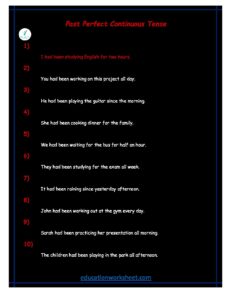converting Past Perfect Continuous Tense negative sentences to positive form
how to converting Past Perfect Continuous Tense negative sentences to positive form
The Past Perfect Continuous Tense, a verb tense that indicates an ongoing action that began and continued up to a certain point in the past, often comes with a negative form. Transforming negative sentences into their positive counterparts involves a shift in verb usage, auxiliary verbs, and the application of positive constructions in the English language.
To convert a negative sentence in the Past Perfect Continuous Tense to its positive form, one must comprehend the basic components and structure of this tense. The formula for creating the Past Perfect Continuous Tense in the positive form involves the auxiliary verbs ‘had been’ + the main verb’s present participle (-ing form).
Here’s a brief breakdown of the structure before delving deeper into the conversion process:
Negative Past Perfect Continuous Tense Structure:

Subject + had not been + present participle (verb + -ing) + object/complement.
Positive Past Perfect Continuous Tense Structure:

Subject + had been + present participle (verb + -ing) + object/complement.
To convert from negative to positive:
- Change the negative auxiliary verb ‘had not been’ to ‘had been’.
- Retain the main verb in its present participle form (verb + -ing).
- Maintain the original subject, object, and any other components of the sentence.
The conversion process necessitates a keen eye for detail and a sound understanding of the English language’s grammatical rules. It’s crucial to ensure accuracy in subject-verb agreement, verb tense consistency, and the correct placement of auxiliary verbs within the sentence structure.
Moreover, the transformation from negative to positive should also consider the context and meaning of the sentence to ensure that the intended message remains unaltered. Clarity, precision, and coherence in communication are essential in this process.
In practice, let’s consider a few examples of converting negative Past Perfect Continuous Tense sentences to their positive counterparts:
Negative Sentence: She had not been waiting for the bus for long. Positive Transformation: She had been waiting for the bus for a while.
Negative Sentence: They had not been studying English for very long. Positive Transformation: They had been studying English for a considerable amount of time.
Negative Sentence: The workers had not been repairing the road all day. Positive Transformation: The workers had been repairing the road throughout the day.
By applying the rules of the Past Perfect Continuous Tense and the process of converting negative sentences to positive ones, the structure, meaning, and context of the original sentence can be successfully transformed while maintaining grammatical accuracy.
converting Past Perfect Continuous Tense negative sentences to positive form

In conclusion, converting negative Past Perfect Continuous Tense sentences to their positive forms involves a comprehensive understanding of grammar, careful adjustment of auxiliary verbs and sentence structure, and a meticulous approach to maintain the intended meaning and clarity within the language. This transformation, when executed accurately, contributes to effective communication in English.

